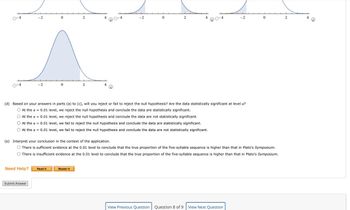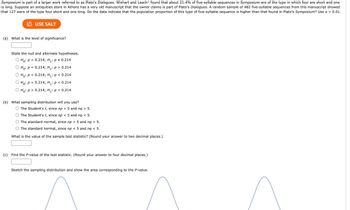
MATLAB: An Introduction with Applications
6th Edition
ISBN: 9781119256830
Author: Amos Gilat
Publisher: John Wiley & Sons Inc
expand_more
expand_more
format_list_bulleted
Question

Transcribed Image Text:0-4
0-4
-2
Need Help?
Submit Answer
0
0
Read It
2
2
Master It
40-4
Q
-2
0
(d) Based on your answers in parts (a) to (c), will you reject or fail to reject the null hypothesis? Are the data statistically significant at level a?
O At the a = 0.01 level, we reject the null hypothesis and conclude the data are statistically significant.
O At the a = 0.01 level, we reject the null hypothesis and conclude the data are not statistically significant.
O At the a= 0.01 level, we fail to reject the null hypothesis and conclude the data are statistically significant.
O At the a = 0.01 level, we fail to reject the null hypothesis and conclude the data are not statistically significant.
2
(e) Interp your conclusion in the context of the application.
O There is sufficient evidence at the 0.01 level to conclude that the true proportion of the five-syllable sequence is higher than that in Plato's Symposium.
O There is insufficient evidence at the 0.01 level to conclude that the true proportion of the five-syllable sequence is higher than that in Plato's Symposium.
20-4
View Previous Question Question 8 of 9
-2
View Next Question
0

Transcribed Image Text:Symposium is part of a larger work referred to as Plato's Dialogues. Wishart and Leacht found that about 21.4% of five-syllable sequences in Symposium are of the type in which four are short and one
is long. Suppose an antiquities store in Athens has a very old manuscript that the owner claims is part of Plato's Dialogues. A random sample of 482 five-syllable sequences from this manuscript showed
that 127 were of the type four short and one long. Do the data indicate that the population proportion of this type of five-syllable sequence is higher than that found in Plato's Symposium? Use a = 0.01.
USE SALT
(a) What is the level of significance?
State the null and alternate hypotheses.
O Ho: P = 0.214; H₁: p = 0.214
O Ho: P = 0.214; H₁: p > 0.214
O Ho: P < 0.214; H₁: p = 0.214
O Ho: P = 0.214; H₁: p < 0.214
Ho: p > 0.214; H₁: p = 0.214
(b) What sampling distribution will you use?
O The Student's t, since np > 5 and nq > 5.
O The Student's t, since np < 5 and nq < 5.
O The standard normal, since np > 5 and nq > 5.
O The standard normal, since np < 5 and nq < 5.
What is the value of the sample test statistic? (Round your answer to two decimal places.)
(c) Find the P-value of the test statistic. (Round your answer to four decimal places.)
Sketch the sampling distribution and show the area corresponding to the P-value.
Expert Solution
This question has been solved!
Explore an expertly crafted, step-by-step solution for a thorough understanding of key concepts.
Step by stepSolved in 6 steps with 3 images

Knowledge Booster
Similar questions
- Please answer all the parts in the picture below as well as the data table, thank you so much :))arrow_forwardIn a memory test, the test subjects are given a large number and are asked to memorize it. Historical records show that 80% of test subjects pass the test. To pass the test, a subject must exactly repeat all the digits in the number after two hours. A random sample of 625 people to take the memory test is going to be chosen. Let p be the proportion of people in the sample who pass the test. Answer the following. (If necessary, consult a list of formulas.) (a) Find the mean of P. 0 (b) Find the standard deviation of p. 0 (c) Compute an approximation for P(P >0.84), which is the probability that more than 84% of the people in the sample pass the test. Round your answer to four decimal places. 0 Xarrow_forwardSuppose we want to estimate the proportion of the Helena population who have used marijuana within the last month. We select 4328 participants and ask them each to first privately draw a card from a standard 52-card deck. If they get a “club” they are asked to respond truthfully to the question “Have you used marijuana within the last month?”If they get any other suit they are asked to respond to the question “Does your phone number end in an odd digit?”The study is blinded in the sense that the researcher doesn’t know which question the participant is answering. Hence, participants are guaranteed anonymity and are more likely to be truthful in their responses. The researchers only get a “yes” or “no” answer from each respondent and don’t know the actual results of the card draw. What is the expected probability of a person’s phone number ending in an odd digit? What is the expected probability of a person’s phone number not ending in an odd digit?arrow_forward
- Symposium is part of a larger work referred to as Plato's Dialogues. Wishart and Leacht found that about 21.4% of five-syllable sequences in Symposium are of the type in which four are short and one is long. Suppose an antiquities store in Athens has a very old manuscript that the owner claims is part of Plato's Dialogues. A random sample of 484 five-syllable sequences from this manuscript showed that 127 were of the type four short and one long. Do the data indicate that the population proportion of this type of five-syllable sequence is higher than that found in Plato's Symposium? Use a = 0.01. n USE SALT (a) What is the level of significance? State the null and alternate hypotheses. O Ho: P = 0.214; H: p > 0.214 O Ho: p > 0.214; H: p = 0.214 O Ho: P = 0.214; H: p + 0.214 O Ho: p 5 and ng > 5. The standard normal, since np 5 and nq > 5. What is the value of the sample test statistic? (Round your answer to two decimal places.) (c) Find the P-value of the test statistic. (Round your…arrow_forwardSymposium is part of a larger work referred to as Plato's Dialogues. Wishart and Leach† found that about 21.4% of five-syllable sequences in Symposium are of the type in which four are short and one is long. Suppose an antiquities store in Athens has a very old manuscript that the owner claims is part of Plato's Dialogues. A random sample of 480 five-syllable sequences from this manuscript showed that 125 were of the type four short and one long. Do the data indicate that the population proportion of this type of five-syllable sequence is higher than that found in Plato's Symposium? Use ? = 0.01. (a) What is the level of significance? State the null and alternate hypotheses. H0: p > 0.214; H1: p = 0.214H0: p = 0.214; H1: p > 0.214 H0: p = 0.214; H1: p ≠ 0.214H0: p < 0.214; H1: p = 0.214H0: p = 0.214; H1: p < 0.214 (b) What sampling distribution will you use? The standard normal, since np > 5 and nq > 5.The Student's t, since np < 5 and nq < 5.…arrow_forwardA researcher uses an anonymous survey to investigate the study habits of American college students. The entire group of American college students is an example of a(n)arrow_forward
- Plz don't copy answer from Chegg Plz answer fast without plagiarism i give up vote 2arrow_forwardIn a survey, it was found that 80% of adults operate the flusher of toilets in public restrooms with their foot. (a) If 300 adults are randomly selected, how many would we expect to flush toilets in public restrooms with their foot? (b) Would it be unusual to observe 255 adults who flush toilets in public restrooms with their foot? (a) We would expect (Type a whole number.) adults to flush toilets in public restrooms with their foot. (b) Would it be unusual to observe 255 adults who flush toilets in public restrooms with their foot? Choose the correct answer below. O A. Yes, because 255 is greater than u + 2o. O B. No, because 255 is greater than u + 20. O C. Yes, because 255 is between u - 20 and u+ 20. O D. No, because 255 is less than u- 20. O E. No, because 255 is between u -20 and u+ 20.arrow_forwardNonearrow_forward
arrow_back_ios
arrow_forward_ios
Recommended textbooks for you
 MATLAB: An Introduction with ApplicationsStatisticsISBN:9781119256830Author:Amos GilatPublisher:John Wiley & Sons Inc
MATLAB: An Introduction with ApplicationsStatisticsISBN:9781119256830Author:Amos GilatPublisher:John Wiley & Sons Inc Probability and Statistics for Engineering and th...StatisticsISBN:9781305251809Author:Jay L. DevorePublisher:Cengage Learning
Probability and Statistics for Engineering and th...StatisticsISBN:9781305251809Author:Jay L. DevorePublisher:Cengage Learning Statistics for The Behavioral Sciences (MindTap C...StatisticsISBN:9781305504912Author:Frederick J Gravetter, Larry B. WallnauPublisher:Cengage Learning
Statistics for The Behavioral Sciences (MindTap C...StatisticsISBN:9781305504912Author:Frederick J Gravetter, Larry B. WallnauPublisher:Cengage Learning Elementary Statistics: Picturing the World (7th E...StatisticsISBN:9780134683416Author:Ron Larson, Betsy FarberPublisher:PEARSON
Elementary Statistics: Picturing the World (7th E...StatisticsISBN:9780134683416Author:Ron Larson, Betsy FarberPublisher:PEARSON The Basic Practice of StatisticsStatisticsISBN:9781319042578Author:David S. Moore, William I. Notz, Michael A. FlignerPublisher:W. H. Freeman
The Basic Practice of StatisticsStatisticsISBN:9781319042578Author:David S. Moore, William I. Notz, Michael A. FlignerPublisher:W. H. Freeman Introduction to the Practice of StatisticsStatisticsISBN:9781319013387Author:David S. Moore, George P. McCabe, Bruce A. CraigPublisher:W. H. Freeman
Introduction to the Practice of StatisticsStatisticsISBN:9781319013387Author:David S. Moore, George P. McCabe, Bruce A. CraigPublisher:W. H. Freeman

MATLAB: An Introduction with Applications
Statistics
ISBN:9781119256830
Author:Amos Gilat
Publisher:John Wiley & Sons Inc

Probability and Statistics for Engineering and th...
Statistics
ISBN:9781305251809
Author:Jay L. Devore
Publisher:Cengage Learning

Statistics for The Behavioral Sciences (MindTap C...
Statistics
ISBN:9781305504912
Author:Frederick J Gravetter, Larry B. Wallnau
Publisher:Cengage Learning

Elementary Statistics: Picturing the World (7th E...
Statistics
ISBN:9780134683416
Author:Ron Larson, Betsy Farber
Publisher:PEARSON

The Basic Practice of Statistics
Statistics
ISBN:9781319042578
Author:David S. Moore, William I. Notz, Michael A. Fligner
Publisher:W. H. Freeman

Introduction to the Practice of Statistics
Statistics
ISBN:9781319013387
Author:David S. Moore, George P. McCabe, Bruce A. Craig
Publisher:W. H. Freeman